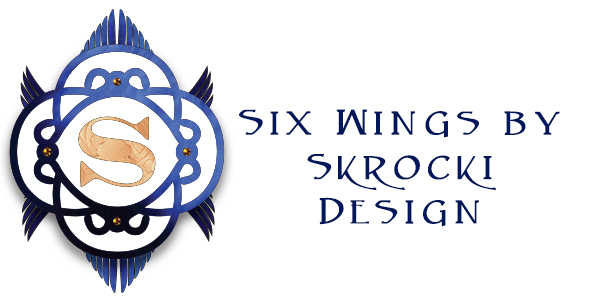 Cutting out the shape of the ring with a jeweller's saw. I have 5 saws, but this one is by far my favourite even though it is made for sawing out large items like bowls, cuffs, etc. They are a little more expensive than regular jeweller's saws so I have this one because it can be used for small and large items.
|
Favourite tool from this project; the Knew Concepts Jeweler's 8" Saw Frame with Cam Lever and Swivel.
 The best saw I own! Description from website: "designed to swing the rear of the frame out of the way. The ability to set the frame into a "neutral corner" frees you to saw into areas that were never possible before. It swivels 45° degrees either to the Right or the Left, and has a lock at the “straight ahead” position" (http://knewconcepts.com/8-inch.php). The best part of this saw which isn't mentioned in this description is the blade can be changed and tightened in a matter of minutes. This is especially important when we have to hand saw hundreds of new items for a show.
|
 Some of the various pieces that will be soldered on top of the sanded ring shanks. We used mostly copper for this batch of shield rings, but usually there are lots of brass, bronze or silver tops.
|
 Hand sawing through almost 100 ring shanks. We hand saw through the ring shanks instead of using our guillotine shears because the shears cut at an angle and there is more sanding to do. We use a tiny belt sander attached to our flexshaft! This is great for production work.
|
 Sanding the tops of the rings for a clean solder. Because we are making the rings out of almost pure copper, the heat from the torch can cause a lot of firescale to occur. Which is basically a black or red stain that appears on mixtures of silver and copper, this can prevent the top of the ring from fully joining to the shank. In the rare case this happens to us, we just give the copper a quick sand and re melt the sterling silver solder. Unfortunately we have not found a better solution than using the same silver solder we use in our sterling silver pieces. Because of this you may see a bit of solder occasionally.
|
 A bunch of rings ready to be tumbled for 12-18 hours with steel shot and a burnishing solution.
|
 The rings after they have been tumbled. They are now hardened, shiny, ready to oxidized and add colour to.
|

Large brass shield ring with a Byzantine cross on the front and medieval tiles on the ring shank. This ring is currently for sale in our online store. The neat thing about this ring it can be worn two ways on your finger the tip facing towards the nail or the tip facing towards the top of the finger. It gives two different looks and they both look like amour for your finger.
|
 Archangel Michael shield ring in brass.
This ring is based on iconography pieces depicting the Arch Angel Michael. The halo is something we based on a massive drawing of a geometric lotus we seen in Egypt.  A view of the side of the ring shows the band also has designs on it. This ring is also for sale on our website here.
A slightly different style we have with the flat top. The image of this ring is describe in another post here and for sale here. The band on this ring is made from pure copper. We make many of the bands made from copper because it is a softer metal for us to form and size than brass or bronze. |
 Sterling silver shield ring , oxidized, lightly sanded and set with blue topaz.
We also do lots of stone set rings as well and occasional I make wire rings which is a completely different process!!
 *An example of one of our wire rings with a glass cabochon I made to look like a dragon’s eye. This ring is sold but I occasionally make more.
Our inventory is so different for every large show. What we have at each show depends on our inventory of stones at any given time. We don’t buy a lot of the same stones in the same sizes so not a lot of each ring is made. If you are looking for a particular style of ring please contact us and we will get back to you about what is in stock or we are in the process of making.
|














































































 #113, 13651, St Albert Trail, Unit 4, Edmonton, Alberta, Canada
#113, 13651, St Albert Trail, Unit 4, Edmonton, Alberta, Canada
 1-780-289-4283
1-780-289-4283